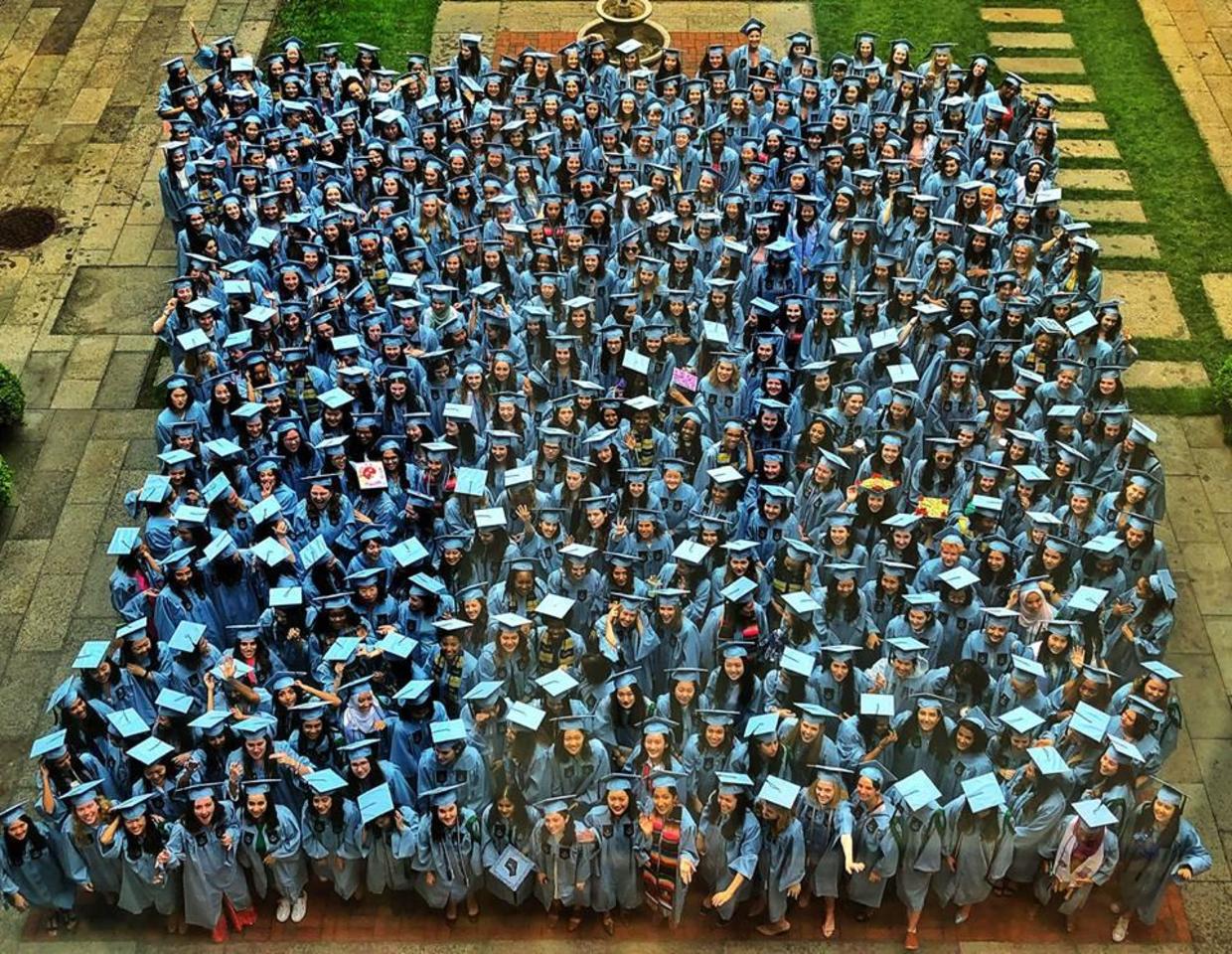1) There is definitely a constant aura of Barnard pride. BUT, by no means do I think that Barnard are the crazy protesting feminists we are often depicted as. I, myself - and tons of my friends - did not apply to Barnard because it is a women's college. Barnard does not pressure you to fight for women's rights, or anything; Barnard wants you to embrace your identity, whatever that may be. There are plenty of boys in classes, in extracurriculars, wandering around campus, out in the nightlife scene, eating in our dining hall, and crashing our awesome Barnard events. That's the difference between a girls' school with boys across the street and a co-ed school.
It takes a little more time and a bit more effort, but it's not as difficult as it may sound. 3) The beautiful thing about Barnard is that there is no archetypal "Barnard girl." I think we all love to learn and we are all intelligent women. Beyond that, there are so many different types of people here that there is a place for everyone. Barnard students worked just as hard to get into Barnard as Columbia students did to get into Columbia and both student bodies continue to work hard.
5) Like every other university, class difficulty varies. There are easier classes and harder classes at both schools. It is unfair to say that one school is easier than the other. 6) When I first got to Barnard, I did sense a bit of tension.
It's not just there waiting for you; you have to put effort into making tension. So, I've found if you don't want tension or competition it won't be there. The tension between girls is the best joke at Columbia.
This admissions data tells us that most of Barnard's admitted students fall within the top 20% nationally on the SAT. For the evidence-based reading and writing section, 50% of students admitted to Barnard scored between 670 and 750, while 25% scored below 670 and 25% scored above 750. On the math section, 50% of admitted students scored between 670 and 770, while 25% scored below 670 and 25% scored above 770. Applicants with a composite SAT score of 1520 or higher will have particularly competitive chances at Barnard.
Barnard is a small, highly selective liberal arts college for women located in New York City. The student body of just over 2,650 is part of a diverse and close-knit community and students study with leading scholars who serve as dedicated, accessible mentors and teachers. Founded in 1889, Barnard also engages in a unique partnership with Columbia University, situated directly across the street. Students have access to cross-registration of courses with Columbia, many joint extracurricular activities, participate in NCAA Division I Ivy League athletics and enjoy a fully coed social life. The location in New York City grants students access to thousands of internship opportunities in addition to unparalleled cultural, intellectual and social resources. Barnard's diverse student body includes residents from nearly every state and more than 55 countries worldwide.
About 40 percent of the student body identify as students of color, and 11 percent are non-US citizens or permanent residents. Barnard is one of the more competitive private colleges or universities in the US, with a 16.70% acceptance rate, an average of 1370 on the SAT, an average of 31 on the ACT and an rough average unweighted GPA of 3.9 . In order to feel secure when applying to this school, it is incredibly useful to to score higher than 90% or more of US test-takers, above a 1370 on the SAT or a 31 on the ACT. At most colleges and universities, the number of students who deferred their enrollment is still unclear – data is not readily available and the situation remains fluid as classes begin. The truth is, acceptance rates at that tiny group of schools are so low to begin with (under 10%), that obsessing about reduced spots in admission is a fool's errand. If Princeton's admit rate is 5.6% instead of 6.5% next year, what will that really mean to an individual student's chances of making it through the gates?
Barnard is one of a handful of outstanding colleges exclusively for women. The entrance standards at Barnard are very tough, but the Admissions process is definitely less competitive than Columbia's. For example, though Barnard matriculates about 550 students per year, it admits 23% of its applicants. Columbia, by contrast, only accepts about 7% of its applicants!
Now once enrolled, Barnard and Columbia seemingly intersect everywhere. Note that they do NOT share dorms, but the Freshman orientation program is completely co-mingled. So yes, I would probably recommend that a student who is in love with Columbia, but not quite qualified to be in the top 25% of the Columbia applicant pool look seriously at Barnard. They are both elite with incredible and strong alumni networks . For those who qualify (academically and 'financially) and fit , either school is a winner.
Barnard College has a highly competitive admissions pool with a low acceptance rate and high average SAT/ACT scores. However, Barnard has aholistic admissions process involving other factors beyond your grades and test scores. Astrong application essay, short answer essay, andglowing letters of recommendationcan strengthen your application, as can participation in meaningfulextracurricular activitiesand arigorous course schedule. Students with particularly compelling stories or achievements can still receive serious consideration even if their test scores are outside of Barnard's range. While not required, applicants can participate in an optional interview either on or off-campus. Barnard College boasts a highly competitive admissions pool with a low acceptance rate and high mean SAT/ACT scores.
However, Barnard has a robust admissions process that involves a multitude of academic measures. A persuasive essay, short answer essay, and glowing recommendation letters can bolster your application, as can along with being involved with student organizations and attempting a challenging course load. Students with unique talents and accomplishments can still receive strong consideration even if their GPAs are outside of the admissions offices mean range. After applying, students will receive a message from an admissions counselor about the next steps of the application process.
Interested students should check out the university's website, which has helpful tips and contact information for the admissions offices. Many of the other colleges were already test optional, she said. As of 2012 Barnard pays Columbia about $5 million a year under the terms of the "interoperate relationship", which the two schools renegotiate every 15 years. Despite the affiliation Barnard is legally and financially separate from Columbia, with an independent faculty and board of trustees. It is responsible for its own separate admissions, health, security, guidance and placement services, and has its own alumnae association. Nonetheless, Barnard students participate in the academic, social, athletic and extracurricular life of the broader University community on a reciprocal basis.
The affiliation permits the two schools to share some academic resources; for example, only Barnard has an urban studies department, and only Columbia has a computer science department. Most Columbia classes are open to Barnard students and vice versa. Barnard students and faculty are represented in the University Senate, and student organizations such as the Columbia Daily Spectator are open to all students. Barnard students play on Columbia athletics teams, and Barnard uses Columbia email, telephone and network services. I became interested in the college admissions process after serving as a student tour guide in the admissions office of my alma mater.
After graduating, I accepted an admissions counseling position at Bennington College in Vermont where I evaluated applications and reviewed art portfolios from students across the country. Three years later, after pursuing my master's degree in New York City, I joined the admissions staff at Barnard College where I served as a senior admissions officer. At Barnard, I directed Long Island and Boston recruitment in addition to managing the College's alumnae interview program, coordinating admissions statistics, and editing various college publications. Having also served as an alumni interviewer for Dartmouth College and visited over 75 colleges, I feel especially well-equipped to help students prepare for admission interviews and campus tours. This year, many selective colleges are seeing applicant pools that are larger than they have ever experienced. As a result, applications submitted via the Common Application rose by 11% over this past year, while the number of applicants only increased by 2.4%.
This indicates that many students may be casting a wider net when it comes to college admissions. This year, waiting lists are expected to be the worst ever . The pandemic has led to a surge in applications at the most competitive colleges -- public and private. The new applications include minority and low-income applicants who in the past felt unwelcome or who are attracted by the fact that many of these colleges were test optional for the first time. (Colleges that cater to these students struggled for applications.) Many of the top colleges also admitted large early-decision/early-action classes. The result of all of these changes is that predicting yield -- the percentage of admitted applicants who enroll -- is likely to be more difficult this year.
And when colleges are worried about yield, they tend to rely more on waiting lists than they do normally. The Office of Admissions is proud to present the Barnard College Class of 2025. Each year we seek to enroll bold, engaged, and intellectually curious students into our community. We are happy to provide statistics on enrollment and financial aid to give you a broad understanding of the candidates we seek to admit to Barnard. These pieces of the application are critical to gaining a full understanding of each candidate and their fit for Barnard.
Founded in 1889 as a women's college when Columbia University was still an all-male institution, Barnard College is now an independent college under the Columbia umbrella. It is fully autonomous, with its own admissions process and curriculum requirements, but Barnard and Columbia students can freely take classes on each other's campuses and participate in clubs. Barnard's location offers its students a variety of work experiences on and off campus.
75% of Barnard students are estimated to complete an internship during their four years at the College. Barnard offered 300 total funded opportunities in Summer 2019. College Factual provides higher-education, college and university, degree, program, career, salary, and other helpful information to students, faculty, institutions, and other internet audiences.
Inclusion on this website does not imply or represent a direct relationship with the company, school, or brand. Information, though believed correct at time of publication, may not be correct, and no warranty is provided. Contact the schools to verify any information before relying on it.
The displayed options may include sponsored or recommended results, not necessarily based on your preferences. For the reading and writing part, 50% of students admitted to Barnard scored between 660 and 760, while 25% scored below 660, and 25% scored over 760. On the math part, 50% of admitted students scored between 650 and 740, while 25% scored below 650, and 25% scored over 740.
Applicants with an overall SAT score of 1500 or higher will have particularly competitive chances at Barnard. Barnard College received over 9,000 applications in 2019. While 45% were enrolled through Early Decision, only 1,097 students were admitted. About 85% of students were in the top decile of their high school. The college is an independent institution with its own policies, but it has a partnership with Columbia University and is considered to be one of the four of its undergraduate colleges. To add to the uncertainty, many colleges experienced a dip in their yield rates last fall.
For example, in 2019, Stanford had a yield rate of 82%, but in the fall of 2020 it dropped below 68%. Similarly, Yale's yield rate decreased from 69% to 55% over the same time period. Consequently, admissions officers will want to ensure that they have a healthy number of waitlisted applicants, to make sure they can fill every seat with a qualified student. As we've said before, colleges fill their waitlists with highly qualified applicants that just barely missed the admit pile.
These students are great fits for the institution– the college just ran out of room when building their well-rounded class. Barnard College had received 9,411 applications but the college only admitted 1,220 applicants and had an acceptance rate of 13% for 2020. Currently college has 2,682 undergraduate students out of total students 11% are international students. At Barnard anyone can find a huge diverse group of friends.
The number of international students at Barnard I think is incredible, which makes for an interesting campus dynamic. Everyone at Barnard is very accepting and it is incredible how hard working and determined some of the girls here are. Many do incredible internship, service work, or are just really fun people. Even though most girls are inevitable bookworms because they are taking very challenging courses, they are usually pretty in tuned in to the world especially cause they are living in New York. Because New York is so exciting most girls make time to get off campus. On the other hand there are lots of girls who are just in the city to play hard and party hard, but there are actually less of those types than I thought there would be .
The only issue that I have experienced affiliated with the bitchy girl stereotype is that in a class with 200 Pre-Med girls things can get awfully tense and competitive. I personally do not like the all girls atmosphere, but have decided to stick it out because everything else at Barnard for me is perfect. You have to be able to handle a lot of estrogen tho because for a lot of girls its really hard to make guy friends. The average SAT score of students admitted into Barnard College is 1404.
On the other hand, the average ACT score of students admitted into the school is 31. The need to have high SAT or ACT scores is one of the things that make the school one of the most selective liberal arts colleges in the nation. This admissions data tells us that most of Barnard's admitted students fall within the top 5% nationally on the ACT. The middle 50% of students admitted to Barnard received a composite ACT score between 31 and 34, while 25% scored above 34 and 25% scored below 31.
This starts with the admissions process; it is a simple statistical truth that the average Columbia student is stronger academically due to being selected more rigorously during applications. There are many Barnard students that are stronger that the average Columbia student, but the mean of the Columbia distribution is undoubtedly higher. This is a signal to employers and further institutions that has nonnegligible value. Admission to Barnard is highly selective and candidates for admission to the first-year class are expected to have taken a highly rigorous college-preparatory program. Barnard requires first-year candidates to submit scores from the SAT Reasoning Test or the ACT. Barnard requires students to display English proficiency and may be required to submit scores from the Test of English as a Foreign Language , the International English Language Testing System or the Duolingo English Test.
Applicants are eligible to have the English Language Proficiency Requirement waived if they meet certain criteria outlined on the website. A private liberal arts college in Amherst, MA with 1849 undergraduate students, Amherst is very selective; the average admitted student has around a 4.0 GPA and a 1458 on the SAT or 33 on the ACT. Barnard and Wellesley have the same graduation rates and pretty much the same number of students. While both schools are highly selective, it's easier to gain admission into Wellesley because of its higher acceptance rate — 21.6% vs. 11.8%. More students are getting financial aid at Wellesley, despite it having slightly lower tuition than Barnard.
Luckily, unlike some Seven Sisters schools and other all-women liberal arts colleges in the country, students at Barnard are not required to live on-campus. This means that they can deduct $15,691 from the sticker price if they wish to live elsewhere, bringing the total cost from $76,279 down to $60,588. While many colleges will waitlist hundreds or even thousands of students, not all of those students will accept a spot on the waitlist, making the pool, and the chances of getting in, slightly better in some cases. According to NACAC, 20% of all students who chose to remain on waitlists were ultimately admitted. However, at selective colleges the average was much lower, with only 7% of students who accepted waitlist spots gaining admission.
This is possibly the hardest question to answer about Barnard. In short, Barnard is a college of Columbia University, meaning your diploma will be from Columbia University, Barnard College. However, Barnard has a completely separate admissions and financial aid process, separate housing, meal plans, and administrative offices. You can take any class at Columbia and any Columbia students can take a class at Barnard. You can go into any dining hall at Columbia, use all the libraries, use the gym, and join clubs and greek life at Columbia.




























